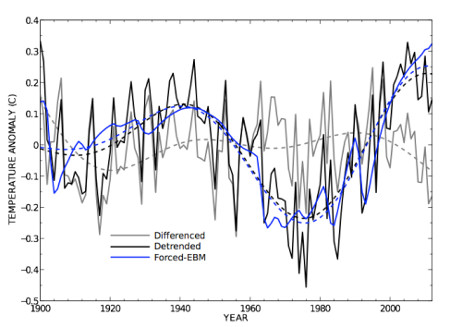
Global warming can't be explained by teleconnections behaving like a stadium wave. Photograph: Christof Koepsel/Bongarts/Getty Images
by John Abraham, "Climate Consensus - The 97%," The Guardian, April 24, 2014
Many people have spent a lot of time trying to show that much of our recentclimate change is just natural. So far, these studies have died as fast as they've been born.
A recent attempt was made to liken our climate to fans in a stadium, you know those annoying "waves" that fans make? Could our climate just be like that? Not likely; let me explain.
The so-called "stadium wave", as described by the scientists who coined the phrase, is "a hypothesized multi-decadally varying climate signal that propagates across the Northern Hemisphere." It is basically a signal that travels throughout the Earth's climate, in the ocean and atmosphere, and can be sensed by measurements. From author Dr. Marcia Wyatt's own website, you can find a more detailed description.
So, could our recent changes in climate be somehow associated with these "waves"? The great thing about science is these hypotheses can be checked. In fact, a very recent study did just that and found the stadium wave hypothesis lacking.
In the study, authors Michael Mann, Byron Steinman, and Sonya Miller estimate the low-frequency internal variability of the Northern Hemisphere (the stadium waves) by evaluating observed signals. These observations include the impacts of both forced (mainly human-caused) variations and natural variability (energy naturally "sloshing around" the Earth). They generated a set of alternative histories based on the statistics of past observations to show that the recent Northern Hemisphere variations are within the range of expected uncertainty.
The authors then show that past analyses which have been used to estimate internal variability have failed to find appropriate variability when it was known ahead of time. These methods errantly show natural variability which is too high and which has a biased phase. As a result, the claims of stadium waves are made based on an incorrect methodology; they are likely an "artifact of this flawed procedure."
To get into the weeds a bit, the primary natural fluctuation that was focused on is called the Atlantic Multi-decadal Oscillation (AMO for short). The recent studies promoting large natural climate variability deduced the AMO by detrending the time series of North Atlantic sea surface temperatures, and then interpreting the left-over low-frequency variation as the AMO. This means they removed a linear variation. Prior works (here and here for instance) have shown that this method causes artifacts to appear. For instance, if you aren't careful, you might conclude that atmospheric aerosol cooling was actually a natural climate fluctuation. That is, you might confuse human-caused cooling effects with natural fluctuations.
 Northern Hemisphere variability comparing differenced, detrended, and forced temperature anomalies.
Northern Hemisphere variability comparing differenced, detrended, and forced temperature anomalies.
The researchers Mann, Steinman and Miller, further showed that the detrended AMO method yields a climatic variability that is approximately twice as large as prior estimates and outside the 95% error range. They also found that the detrending method got the timing wrong (biasing error in the phase). They compared the true AMO signal and the detrended AMO signal. The detrended signals have amplitudes which are too large by a factor of 2 and they are all in phase. As the authors write, this suggests, "an artifact of the common forced signal masquerading as coherent low-frequency noise."
As I've written about before, studies which purport to show that significant recent climate variability is just natural are taken seriously by the scientific community. In fact, I think we would all like to conclude that the current climate change is just natural. During the course of scientific investigation, these claims are given their fair hearing. Unfortunately, they have not borne scientific scrutiny well. Distinguished Professor of Meteorology Michael E. Mann told me,
"Some researchers have in the past attributed a portion of Northern Hemispheric warming to a warm phase of the AMO. The true AMO signal, instead, appears likely to have been in a cooling phase in recent decades, offsetting some of the anthropogenic warming temporarily.We conclude that the AMO played at least a modest role in the apparent slowing of warming during the past decade. As the AMO is an oscillation, this cooling effect is likely fleeting, and when it reverses, the rate of warming will increase.Initial investigations into the multidecadal climate oscillation in the North Atlantic were hampered by the short length of the instrumental climate record which was only about a century long. And some of the calculations were contaminated by long-term climate trends driven or "forced" by human factors such as greenhouse gasses as well as pollutants known as 'sulphate aerosols.' These trends masqueraded as an apparent oscillation."
My own view is that a bit too much is made of these "waves." Humans like to find patterns and give names to patterns that are either real or imaginary. Certainly there are teleconnections between various parts of the climate and certainly those connections might manifest in slow (low frequency) climate variations. But we have a very short history of measurement. In order to be certain, we need measurements of multiple recurrences of the oscillations. We just don't have a long enough period of data.
We also need a clear articulation of the physical processes which cause fluctuations. We do not have that either. Until then, we are just whistling in the breeze (or "yodeling in the broccoli," as we say in Minnesota).
With that said, this doesn't mean we shouldn't continue our search for such important fluctuations. When scientists propose natural variability as a climate-change mechanism, it makes the science better. Either they are right (and we are all better off) or they are wrong (as happened here). Regardless, at the end of the day, our understanding is deeper than before.







No comments:
Post a Comment